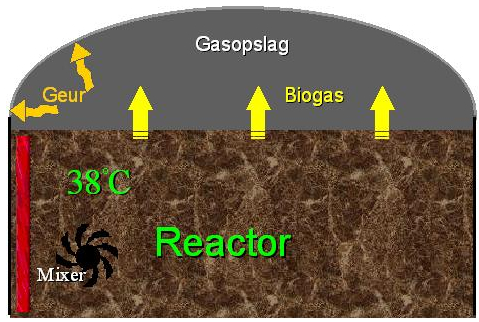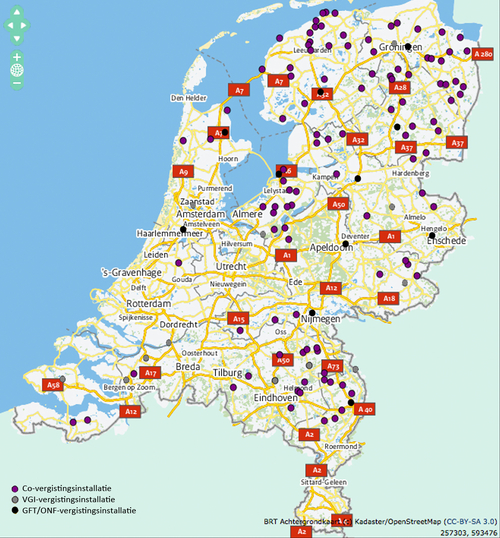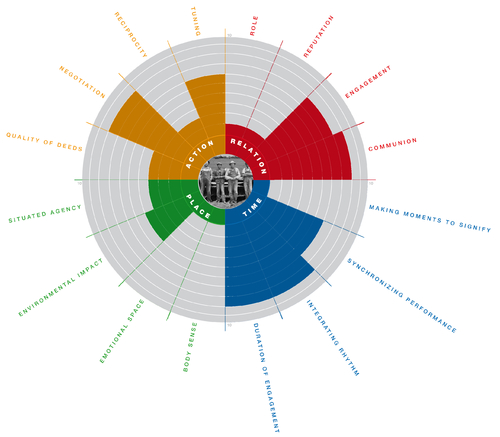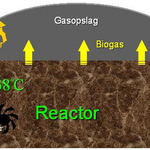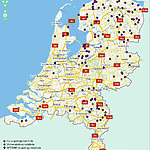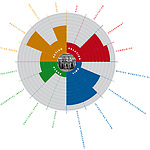To implement a successful biodigester on Texel, first has to be analysed which actors have to be involved and what their needs are. Before going into detail on Texel, first general information about biodigesters is given in the subchapter ‘technology’.
Technology:
The technology of biodigesters
Anaerobic digestion in a biodigester is a process by which microorganisms break down biodegradable materials without the presence of oxygen. The purpose of this process is twofold: to manage waste and/or to produce fuels (Climate Gate, 2012).
A biodigester gives two products as output: biogas and fertilizer. The biogas can be used as an energy source in different industries. The fertilizer can be used in for instance the aquaculture and it can go back to the farms. The input of biodigester consists of biomass. This is often mainly manure, but can also be other organic products such as vegetable and fruit waste. The products that may be used in Dutch biodigesters are listed in the ‘white list’ (which is defind by the ministry).
Biodigesters vary from very small systems in private gardens to very large installations on plants. The figure below shows the main components of the system.
Biodigesters in the Netherlands
In 2012, 232 biodigesters were located in the Netherlands (see the picture below). These installations need huge amounts of biomass, thus manure and co-products. The supply to the Dutch biodigesters is decreasing since a lot of it is transported to Germany. In Germany over 5000 biodigesters are located that together have a huge demand of biomass. Because of the German and France competitors, the price of Dutch biomass is high and this makes it hard for Dutch biodigesters to stay affordable (Ypma, 2011). As the picture below shows, on Texel there is no biodigester located yet.
Biodigester on Texel
The key players needed to set up a biodigester company are ofcourse the suppliers of biomass and the operator of the biodigester. However, it would be shortsighted to only look at these two actors. Building a biodigester would have a large impact on the island and its residents. It would influence the landscape and people might be afraid of the reek it might bring. The rules and regulations that concern the biodigester are made on a national level. Therefore the actor analysis below includes the biodigester company, the suppliers, the municipality, the residents and the national government.
Actor analysis
The biodigester company
Biodigesters can be owned by a private company (http://www.simgas.nl/ ), but often it is exploited by a group of farmers (for instance: https://www.cda.nl/actueel/toon/biogasinstallatie-duurzaam-landleven-bernheze-in-heeswijk-dinther-genomineerd-voor-innovatiepr/) . Together they can share the financial risks and produce a lot of manure and co-products. Owning a biodigester has two main advantages for farmers: it is a way to manage their manure and they can use the output (fertilizer) for their fields. Also, they can use the energy (biogas) for their greenhouses for example.
Farmers are definitely present on Texel: agriculture is dominating the landscape. Half of the island is in use for crops, cattle farms and horticulture farms. 15% of the working population on Texel works in these industries. About 175 farms are located on the island. They own about 4500 ha grassland, 4000 ha of crops and 500 ha horticulture (Boerenklasse). The cattle farms are often small and extensive. The farms have cows (for milk production and/or meat production) and almost 14,000 sheep.
A collective of farmers that together exploit the biodigester seems the best solution. The illustration below shows the needs of such a collective. In such a collective negotiation and tuning is very important. The farmers have to trust each other and communicate with each other often. Therefore are also engagement and communion important. Time is the most dominant aspect of the needs of the collective. It is important that the farmers integrate the biodigeter into the rhytm and see it is a durable engagement.
Suppliers of biomass
The most important suppliers for the biodigester are ofcourse the farmers. The biomass will come from agriculture, cattle breedings and mushroom cultivation. The interrelations are displayed in the illustration of the future design. The operator of the biodigister will pay the suppliers for the biomass (unless the operator is the supplier ofcouse). It is important that the supplied biomass is purely organic and biodagrable and that the materials are on the ‘white list’.
Dutch government
Currently, biodigesters in the Netherlands cannot exist without subsidies.
Biodigester installations qualify for the Milieukwaliteit Electriciteit Productie (MEP) subsidy and the Energie-investeringsaftrek (EIA) which can save coorporation tax (in Dutch: vennootschapbelasting).
However, these subsidies are often too low and uncertain for entrepreneurs to take the risk of building a biodigester. Besides, the white list (that says which products may be used in the biodigester) is too limited. Products such as coffee waste are seen as garbage and are not aloud as input for a biodigester. Most Dutch biodigesters are not profitable due to these causes. Biodigesters in surrounding countries such as France and Germany have a longer white list and therefore outcompete Dutch biodigesters. It is important for the implementation of a biodigester on Texel that the white list is extended and that the subsidies give certainty to the future operator of the biodigester.
The municipality of Texel
To build a biodigester, several licenses are required. The municipality claims that they want a sustainable and energy independent island. Since a biodigester would contribute to that ideal, the municipality has to support the implementation and should give the right licenses. It would also be the task of the municipality to inform local residents.
Local residents
It happened before that local residents stopped the construction of a biodigester by protesting against it (see http://www.deweekkrant.nl/pages.php?page=436680). Neighbors can be concerned about the environmental impact of the biodigester without knowing that the particulates of a highway are much more dangerous for health and that biodigesters decrease the emissions of the manure. It is the task of the municipality to inform the local residents about the advantages and it is the task of the operators of biodigesters to be transparant.
Actions needed by stakeholders
To successfully implement a biodigster on Texel, several actions need to be taken first. Farmers should form a collective that wants to exploit the biodigester. The size of the collective can vary between 5 and 40 farmers. The collective has collect enough money (also with subsidies) to build a biodigester. It is also important that they have good contacts and contract with other biomass suppliers (for example with Maarten Dijker of the mushroom cultivation). The municipality has to give the right permissions for the construction of the biodigester. Besides, the municipality has the task to inform local residents and in this way try to prevent protests. On the higher governmental level it is important that the white list gets extended with the types of biomass present on the island. In that way, also suppliers of for example coffee waste can join.
Bibliography
Agentschap NL. (n.d.). Ministerie van Economische Zaken. Retrieved 12 14, 2014, from bio: http://www.b-i-o.nl/
Boerenklasse. (n.d.). Het boerenleven op Texel. Retrieved 12 14, 2014, from Boerenklasse: http://www.boerenklasse.nl/het-boerenleven
Climate Gate. (2012, 11 17). biovergisters aan de schandpaal. Retrieved 12 14, 2014, from Climate Gate.NL: http://climategate.nl/2012/11/17/biovergisters-aan-de-schandpaal/
Ypma, T. (2011). Boeren met biomassa beter af in buitenland. Boerderij , 5 (2), 47.
